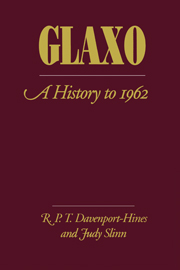Book contents
- Frontmatter
- Contents
- List of illustrations
- List of tables
- Acknowledgements
- Introduction
- Part I Merchants and bonnie babies
- Part II Pharmaceuticals in Britain
- Part III Internationalisation of pharmaceuticals
- 10 Glaxo Laboratories and the international development of the pharmaceutical industry
- 11 Across the Atlantic: North and South America
- 12 The Commonwealth I: India and Pakistan
- 13 The Commonwealth II: Australia and New Zealand
- 14 The Commonwealth III: South Africa
- 15 Glaxo in Europe
- 16 Epilogue
- Appendix: Glaxo statistics
- Notes
- Select bibliography
- Index
13 - The Commonwealth II: Australia and New Zealand
Published online by Cambridge University Press: 05 March 2012
- Frontmatter
- Contents
- List of illustrations
- List of tables
- Acknowledgements
- Introduction
- Part I Merchants and bonnie babies
- Part II Pharmaceuticals in Britain
- Part III Internationalisation of pharmaceuticals
- 10 Glaxo Laboratories and the international development of the pharmaceutical industry
- 11 Across the Atlantic: North and South America
- 12 The Commonwealth I: India and Pakistan
- 13 The Commonwealth II: Australia and New Zealand
- 14 The Commonwealth III: South Africa
- 15 Glaxo in Europe
- 16 Epilogue
- Appendix: Glaxo statistics
- Notes
- Select bibliography
- Index
Summary
In both Australia and New Zealand Glaxo's presence had been long established, but the size and strength of the operations varied. Although the subsidiary in Australia grew and by the end of the period it was, in terms of capital employed, the third largest of Glaxo's overseas subsidiaries, its profitability did not rank commensurately. New Zealand, although it occupied a special place in the affections of the parent company, came to represent, not surprisingly, a very small market in the 1950s and 1960s for Glaxo worldwide.
Australia
The immediate post-war period presented many problems in Australia. The subsidiary's scattered premises across Melbourne and at Port Fairy were inconveniently laid out and inadequate for business expansion. Both the Australian and New Zealand governments subsidised milk production for dried powder so that, for example, in 1946, the cost per ton of milk powder delivered at Greenford was £88 from Australia, £97 from New Zealand and £157 from Britain. The threat of the gradual ending of these subsidies had disturbing implications for the group's costs. For the pharmaceutical side, additional accommodation was recognised as imperative for the proper expansion of the penicillin business, but Rupert Pearce, sent out in the late 1930s to run the Australian company, found the utmost difficulty in solving the problem.
During the war Australian penicillin production had begun by a government- owned institution, Commonwealth Serum Laboratories (CSL).
- Type
- Chapter
- Information
- GlaxoA History to 1962, pp. 298 - 314Publisher: Cambridge University PressPrint publication year: 1992



